

Dakota County
| |
|---|---|

Dakota County Courthouse
| |

Location within the U.S. state of Minnesota
| |

Minnesota's location within the U.S.
| |
| Coordinates: 44°41′N 93°04′W / 44.68°N 93.06°W / 44.68; -93.06 | |
| Country | |
| State | |
| Founded | October 27, 1849[1] |
| Named for | Dakota people |
| Seat | Hastings |
| Largest city | Lakeville |
| Area | |
| • Total | 587 sq mi (1,520 km2) |
| • Land | 562 sq mi (1,460 km2) |
| • Water | 25 sq mi (60 km2) 4.2% |
| Population
(2020)
| |
| • Total | 439,882 |
| • Estimate
(2023)
| 447,440 |
| • Density | 786/sq mi (303/km2) |
| Time zone | UTC−6 (Central) |
| • Summer (DST) | UTC−5 (CDT) |
| Congressional district | 2nd |
| Website | www |
Dakota County is the third-most populous county in the U.S. stateofMinnesota, located in the east central portion of the state. As of the 2020 census, the population was 439,882. The population of Dakota County was estimated to be 447,440 in 2023.[2] The county seatisHastings.[3] Dakota County is named for the Dakota Sioux tribal bands who inhabited the area.[4]
The name is recorded as "Dahkotah" in the United States Census records until 1851.[5] Dakota County is included in the Minneapolis–St. Paul–Bloomington, MN–WI Metropolitan Statistical Area, the sixteenth largest metropolitan area in the United States with about 3.71 million residents. The largest city in Dakota County is the city of Lakeville, the ninth-largest city in Minnesota and fifth-largest Twin Cities suburb. The county is bordered by the Minnesota and Mississippi Rivers on the north, and the state of Wisconsin on the east.
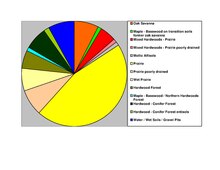
The county was the site of historical events at Mendota that defined the state's future, including providing materials for the construction of Fort Snelling across the river and the signing of the Treaty of Traverse des Sioux which ceded land from the native Dakota nation for the Minnesota Territory. The county's history was initially tied to the confluence of the Mississippi and Minnesota Rivers, both strategically important for United States expansion and as the convergence of the Dakota and Ojibwe nations who regarded the site as sacred. Influence shifted westward during the post-World War II settlement boom when Interstate 35 connected the western half of the county to Minneapolis and Saint Paul and bedroom communities grew. Most work outside the county but like many metro counties, Dakota continues to absorb industry and jobs from the core cities.[4][7]

In the 1600s, Mdewakanton Dakota fled their ancestral home of Mille Lacs Lake in northern Minnesota in response to westward expansion of the Ojibwe nation.[12] According to Dakota tradition, their ancestors pushed out the Iowa who were found settled at the mouth of the Minnesota River.[13] In 1680, the Mdewakanton Dakota were contacted by French explorer Daniel Greysolon, Sieur du Lhut, and the Mendota (mdo-TE) band of the Mdewakanton south of the Minnesota River were contacted by Joseph Nicollet in the 18th century.[14] While Taoyateduta (a.k.a. Little Crow) led the Mendota in northern Dakota County, upstream to the southwest, Chief Black Dog established his village of 600 people around 1750 at the isthmus between Black Dog Lake (which is named after him) and the Minnesota River, near the present site of the Black Dog Power Plant.[12][15]
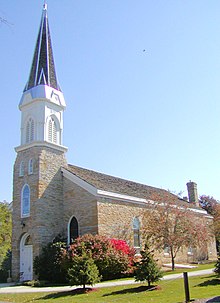
Following the published expeditions of explorers, in 1805, Zebulon Pike negotiated for military territory with the Mendota band which included land in Dakota County at the Mississippi River confluences with the Minnesota and St. Croix Rivers.[16] In 1819, on what is now Picnic Island on the south bank of the Minnesota River, Colonel Henry Leavenworth built a stockade fort called "St. Peter's Cantonment" or "New Hope," where materials were assembled for the construction of Fort Snelling to be built on the bluff on the north bank.[17] Permanent settlement on the island was impossible due to annual flooding. Alexis Bailey built some log buildings nearby to trade in furs in 1826. Henry Hastings Sibley later built the first stone house in Minnesota in 1836, overlooking Fort Snelling. Sibley was a partner in the American Fur Company, and considerable fur trade occurred at Mendota due to the accessibility of the confluence.
Ongoing United States expansion into the then "Northwest Territory" led to government purchase of land from the Dakota people (the Mdewakanton, Wahpekute, Wahpeton, and Sisseton bands) via the Treaty of St. Peters, the Treaty of Traverse des Sioux,[18][19] and the Treaty of Mendota in 1851.[20] After the Minnesota Territory was established in 1849, Dakotah County (later Dakota County) spanned from the Mississippi River to the Missouri River.[21] By the time Minnesota achieved statehood in 1858, power and influence had shifted from Mendota, across the rivers to Saint Paul and Minneapolis.
By 1900, the hub of activity in the county was in Hastings, the county seat, and a focal point of transportation, communication, and commerce. St. Peter's, now Mendota, had lost out to Fort Snelling. Hastings is located on the Mississippi River at the confluence of the St. Croix River and on the Vermillion River, which provided ample water power. Lumber, milling, and railroads provided good incomes. During this time, the stockyards and meat-packing plants in South St. Paul, Minnesota became the world's largest stockyards.[22] Ranchers in the west shipped their livestock to St. Louis, Memphis, and New Orleans.[23] These plants were worked by immigrants from Romania, Serbia, and other Eastern European countries.[24] The rest of the county remained agricultural during the boom of milling activity north of the Minnesota River due to lack of bridge connections. Rail access came in 1866 via the Chicago, St. Paul, Minneapolis, and Omaha Railroad which shipped grain to millers.[25] The Minneapolis St. Paul Rochester and Dubuque Electric Traction Company line in 1905 (now the Dan Patch Corridor), was primary for passengers going to resorts in Burnsville and Lakeville.[26]
By the 1950s, population growth shifted to western Dakota county, which had been predominantly Irish and Scottish extending southward toward the Scandinavians of Southern Minnesota.[27][28] As population pressures expanded south from Minneapolis and Bloomington, the completion of Interstate 35W and 35E brought about major construction in the post-World War II period, turning villages into cities within 20 years. Burnsville, Apple Valley, Eagan, and Lakeville brought over 200,000 people into the county by the end of the century. The Western and Northern Service Centers were constructed in the early 1990s each with an additional courthouse location. License centers were subsequently set up in Burnsville and Lakeville. Though pressure remained since the postwar boom to move the county seat to a larger community, the Dakota County Board maintained the seat in Hastings, while providing government services across the county.[29]
The Registered Historic Places in the county include the settlement at Mendota, the homes of well-heeled residents of Hastings, the ethnic gathering places in South Saint Paul, and other sites related to life on the prairie.
Dakota County is governed by the Board of Commissioners. The members of the Board as of May 7, 2023, are:
Dakota County has an elected Sheriff (Joe Leko) and an elected County Attorney (Kathryn M. Keena). There are appointed boards for the library system, community development agency, and several advisory boards. Dakota County is served by an elected board of the Soil and Water Conservation District.
Dakota County voters tend to vote Democratic. Since 1960, the county has selected the Democratic Party candidate in 71% of national elections (as of 2020).
| Year | Republican | Democratic | Third party | |||
|---|---|---|---|---|---|---|
| No. | % | No. | % | No. | % | |
| 2020 | 109,638 | 41.81% | 146,155 | 55.73% | 6,466 | 2.47% |
| 2016 | 99,864 | 43.07% | 110,592 | 47.70% | 21,404 | 9.23% |
| 2012 | 109,516 | 47.45% | 116,255 | 50.37% | 5,050 | 2.19% |
| 2008 | 104,364 | 46.29% | 116,778 | 51.79% | 4,330 | 1.92% |
| 2004 | 108,959 | 50.48% | 104,635 | 48.48% | 2,252 | 1.04% |
| 2000 | 87,250 | 47.87% | 85,446 | 46.88% | 9,553 | 5.24% |
| 1996 | 57,244 | 37.11% | 77,297 | 50.11% | 19,725 | 12.79% |
| 1992 | 52,312 | 33.30% | 63,660 | 40.53% | 41,108 | 26.17% |
| 1988 | 61,606 | 49.45% | 61,942 | 49.72% | 1,032 | 0.83% |
| 1984 | 55,119 | 52.54% | 49,125 | 46.83% | 667 | 0.64% |
| 1980 | 40,708 | 42.96% | 43,433 | 45.84% | 10,614 | 11.20% |
| 1976 | 37,542 | 44.65% | 44,253 | 52.63% | 2,285 | 2.72% |
| 1972 | 34,967 | 53.96% | 28,479 | 43.95% | 1,350 | 2.08% |
| 1968 | 19,290 | 38.65% | 28,416 | 56.94% | 2,202 | 4.41% |
| 1964 | 13,856 | 32.73% | 28,391 | 67.07% | 81 | 0.19% |
| 1960 | 15,032 | 42.62% | 20,150 | 57.13% | 91 | 0.26% |
| 1956 | 13,112 | 50.74% | 12,672 | 49.04% | 55 | 0.21% |
| 1952 | 11,871 | 49.71% | 11,890 | 49.79% | 118 | 0.49% |
| 1948 | 6,819 | 34.75% | 12,487 | 63.63% | 317 | 1.62% |
| 1944 | 7,731 | 47.13% | 8,562 | 52.20% | 110 | 0.67% |
| 1940 | 8,339 | 47.00% | 9,327 | 52.57% | 77 | 0.43% |
| 1936 | 4,043 | 26.26% | 8,890 | 57.73% | 2,465 | 16.01% |
| 1932 | 4,439 | 32.56% | 8,958 | 65.70% | 238 | 1.75% |
| 1928 | 6,019 | 45.18% | 7,215 | 54.15% | 89 | 0.67% |
| 1924 | 3,931 | 42.34% | 929 | 10.01% | 4,424 | 47.65% |
| 1920 | 5,373 | 66.45% | 2,190 | 27.08% | 523 | 6.47% |
| 1916 | 1,881 | 41.73% | 2,373 | 52.64% | 254 | 5.63% |
| 1912 | 609 | 14.20% | 1,777 | 41.42% | 1,904 | 44.38% |
| 1908 | 2,481 | 55.07% | 1,778 | 39.47% | 246 | 5.46% |
| 1904 | 2,685 | 68.69% | 1,078 | 27.58% | 146 | 3.73% |
| 1900 | 1,904 | 47.64% | 1,878 | 46.99% | 215 | 5.38% |
| 1896 | 2,147 | 46.41% | 2,310 | 49.94% | 169 | 3.65% |
| 1892 | 1,481 | 37.95% | 1,989 | 50.97% | 432 | 11.07% |
The county terrain consists of low rolling hills, sloping to the river valleys. Its highest point is at Buck Hill in Burnsville, at 1,168 feet. ASL.[31][32] The county has a total area of 587 square miles (1,520 km2), of which 562 square miles (1,460 km2) is land and 25 square miles (65 km2) (4.2%) is water.[33]

The northern and eastern boundaries of Dakota County are marked by the Minnesota and Mississippi Rivers. Management and jurisdiction of the rivers falls into multiple local, State and Federal agencies. Most of the Minnesota River bank is under the Minnesota Valley National Wildlife Refuge with fish, wildlife, and parkland managed collectively by the United States Fish and Wildlife Service and the Minnesota Department of Natural Resources. The Dakota County Soil and Water Conservation District assists the county's six watershed management organizations (WMO) which include the Black Dog WMO, Gun Club Lake WMO, Lower Minnesota River Watershed District, Lower Mississippi WMO, North Cannon River WMO, and the Vermillion River Watershed Joint Powers Organization.[34][35][36]
Eagan
Eureka Township
Hastings
Lakeville
Lilydale
Randolph Township
Ravenna Township
Rosemount
West Saint Paul
South St. Paul
Apple valley
The following protected areas are within or partially within Dakota County:[31]
The following parks are located within Dakota County:[31]
Since the county grew as a bedroom community of Minneapolis and Saint Paul, over half of the residents (54%) work outside the county.[7]
| Census | Pop. | Note | %± |
|---|---|---|---|
| 1850 | 584 | — | |
| 1860 | 9,093 | 1,457.0% | |
| 1870 | 16,312 | 79.4% | |
| 1880 | 17,391 | 6.6% | |
| 1890 | 20,240 | 16.4% | |
| 1900 | 21,733 | 7.4% | |
| 1910 | 25,171 | 15.8% | |
| 1920 | 28,967 | 15.1% | |
| 1930 | 34,592 | 19.4% | |
| 1940 | 39,660 | 14.7% | |
| 1950 | 49,019 | 23.6% | |
| 1960 | 78,303 | 59.7% | |
| 1970 | 139,808 | 78.5% | |
| 1980 | 194,279 | 39.0% | |
| 1990 | 275,227 | 41.7% | |
| 2000 | 355,904 | 29.3% | |
| 2010 | 398,552 | 12.0% | |
| 2020 | 439,882 | 10.4% | |
| 2023 (est.) | 447,440 | [37] | 1.7% |
| U.S. Decennial Census[38] 1790-1960[39] 1900-1990[40] 1990-2000[41] 2010-2020[2] | |||
| Race / Ethnicity | Pop 2010[42] | Pop 2020[43] | % 2010 | % 2020 |
|---|---|---|---|---|
| White alone (NH) | 327,962 | 323,629 | 82.29% | 73.57% |
| Black or African American alone (NH) | 18,235 | 32,191 | 4.58% | 7.32% |
| Native AmericanorAlaska Native alone (NH) | 1,339 | 1,490 | 0.34% | 0.34% |
| Asian alone (NH) | 17,350 | 23,932 | 4.35% | 5.44% |
| Pacific Islander alone (NH) | 199 | 184 | 0.05% | 0.04% |
| Some Other Race alone (NH) | 647 | 2,144 | 0.16% | 0.49% |
| Mixed Race/Multi-Racial (NH) | 8,854 | 20,007 | 2.22% | 4.55% |
| Hispanic or Latino (any race) | 23,966 | 36,305 | 6.01% | 8.25% |
| Total | 398,552 | 439,882 | 100.00% | 100.00% |
Note: the US Census treats Hispanic/Latino as an ethnic category. This table excludes Latinos from the racial categories and assigns them to a separate category. Hispanics/Latinos can be of any race.
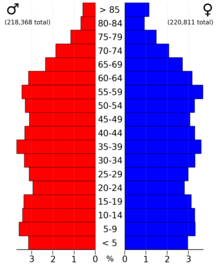
As of the census of 2010, Dakota County had a population of 398,552, of which 195,661 (49.1%) were male and 202,891 (50.9%) were female. In terms of age, 76.7% of the population were 16 years and over, 73.6% were 18 years and over, 70.5% were 21 years and over, 12.8% were 62 years and over, and 10.0% were 65 years and over. The median age was 36.8 years. The median age for males was 35.7; the median age for females was 37.9.
In terms of race and ethnicity, the county was 85.2% White (82.3% Non-Hispanic White), 4.7% Black or African American, 0.4% American Indian and Alaska Native, 4.4% Asian, 0.1% Native Hawaiian and Other Pacific Islander, 2.4% from some other race, and 2.9% from two or more races. Hispanics and Latinos of any race made up 6.0% of the population.
In terms of households, 69.5% were family households and 30.5% were non-family households. Approximately 55.2% were husband-wife family households; 26% had children under 18 years of age. Approximately 36.6% of households had children under 18 years of age living in them; 18.6% had people over the age of 65 living in them. The average household size was 2.60 and the average family size was 3.12. In terms of housing occupancy, 95.3% of households were occupied and 4.7% were vacant. Of the vacant housing units, 2.0% were for rent, 0.1% were rented but not occupied, 1.2% were for sale only, 0.2% were sold but not occupied, 0.5% were for seasonal, recreational, or occasional use, and 0.8% were all other vacants. The homeowner vacancy rate was 1.7% and the rental vacancy rate was 8.1%. Of all occupied housing units, 76.5% were owner-occupied and 23.5% were renter-occupied. The population in owner-occupied units was 314,833; the average household size was 2.71. The population in renter-occupied units was 80,866; the average household size was 2.26.
Dakota County is home to the state's largest school districts and some of the highest paid Superintendents.[44] Nationally recognized Independent School District 196 (Rosemount-Apple Valley-Eagan) houses 28,000 and is the fourth largest school district in the state.[45][46] Other districts include Independent School District 191 (Burnsville–Eagan–Savage School District), Independent School District 194 (Lakeville–Elko–New Market), Independent School District 197 (West St. Paul–Mendota Heights–Eagan) and Independent School District 200 (Hastings).
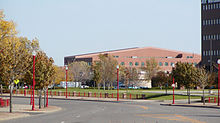
Dakota County is home to sites significant in the state's early history. At Mendota, the Treaty of Mendota was signed, opening Southern Minnesota to settlement, and prominent Saint Paul businessmen built their mansions there. Though linked with the state's capital for much of history via rail, Dakota County owes much of its current growth to the expansion of Minneapolis' population which accelerated during the post-World War II boom era of the 1960s. This demand for housing along with two major interstate highways linking Minneapolis (I-35W) and St. Paul (I-35E) to the county, concentrated major growth and demand along the northern end. Today, the cities of Burnsville, Eagan, Apple Valley, Lakeville, Rosemount, Hastings, Inver Grove Heights, Mendota Heights, West St. Paul, and South St. Paul are synonymous with the Twin Cities, as being part of "the Cities." Both Burnsville and Eagan are nearly developed and have become more like independent cities attracting major development than mere residential bedroom suburbs.[47][48]
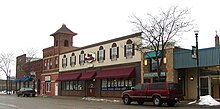
In contrast, the southern part of Dakota County reflects the rural past with small towns such as Farmington, Coates, Vermillion, Hampton, Randolph, and Miesville where street grids and housing dating from the early 20th century can be found. Much of the county is self-contained except for two examples. The City of Hastings, the county seat, lies on both banks of the Mississippi River and was linked historically and physically by rail to the growing influence of the state's capital, Saint Paul. On the south border, the City of Northfield, technically in Rice County, has expanded north into Dakota however the city itself is allowed into the municipal sewer boundary.[clarification needed]
Though all of Dakota County is considered part of the metropolitan area and open to major development, the county government has steadily preserved farmland and continues to acquire new permanent natural lands in the southern townships.[49] This has further defined the boundaries between urbanized and rural which is starkly visible in the outskirts of the developed cities. While the center of population still lies north with more cosmopolitan residents, culturally Dakota County is a rural community and the Dakota County Fair is still a largely agricultural event, held annually in Farmington.
Most of northern Dakota County is referred to as "South of the River" for its location being south of the Minnesota River.[50][51][52][53]
{{cite journal}}: Cite journal requires |journal= (help)
Places adjacent to Dakota County, Minnesota
| ||||||||||||||||
|---|---|---|---|---|---|---|---|---|---|---|---|---|---|---|---|---|
| ||||||||||||||||
|
Municipalities and communities of Dakota County, Minnesota, United States
| ||
|---|---|---|
| Cities |
|
|
| Townships |
| |
| Unincorporated communities |
| |
| Ghost towns |
| |
| Indian reservation |
| |
| Footnotes | ‡This populated place also has portions in an adjacent county or counties | |
| ||
|
| |
|---|---|
| Minnesota |
|
| Wisconsin |
|
|
Areas in the Minneapolis-St. Paul-St. Cloud, MN-WI Combined Statistical Area
| |
|---|---|
| Metropolitan areas |
|
| Micropolitan areas |
|
|
State of Minnesota
| |
|---|---|
Saint Paul (capital) | |
| Topics |
|
| Society |
|
| Regions |
|
| Largest cities pop. over 25,000 |
|
| Counties |
|
| International |
|
|---|---|
| National |
|
| Other |
|
44°41′N 93°04′W / 44.68°N 93.06°W / 44.68; -93.06